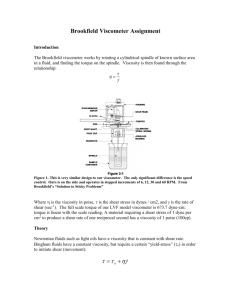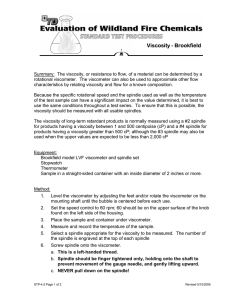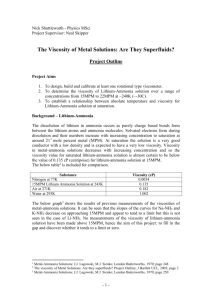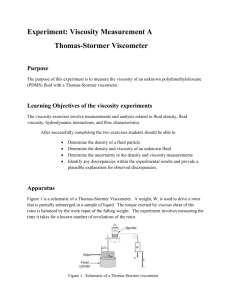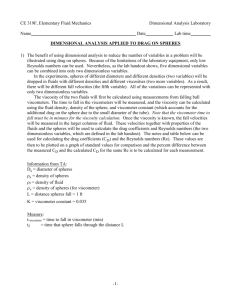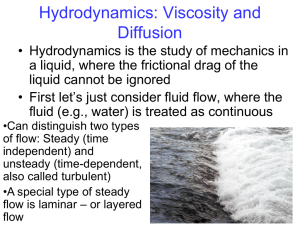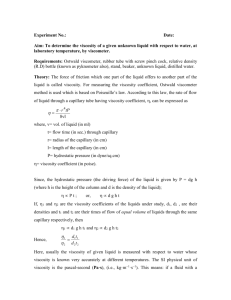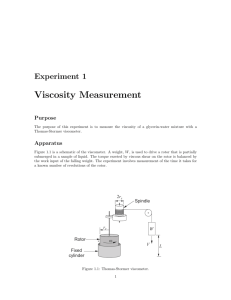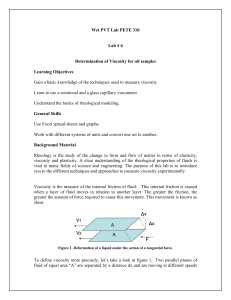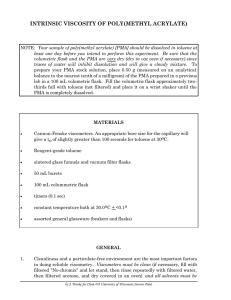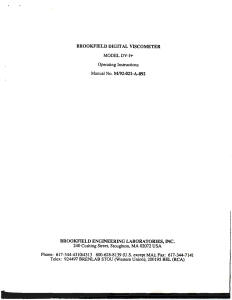Viscosity Measurement
advertisement
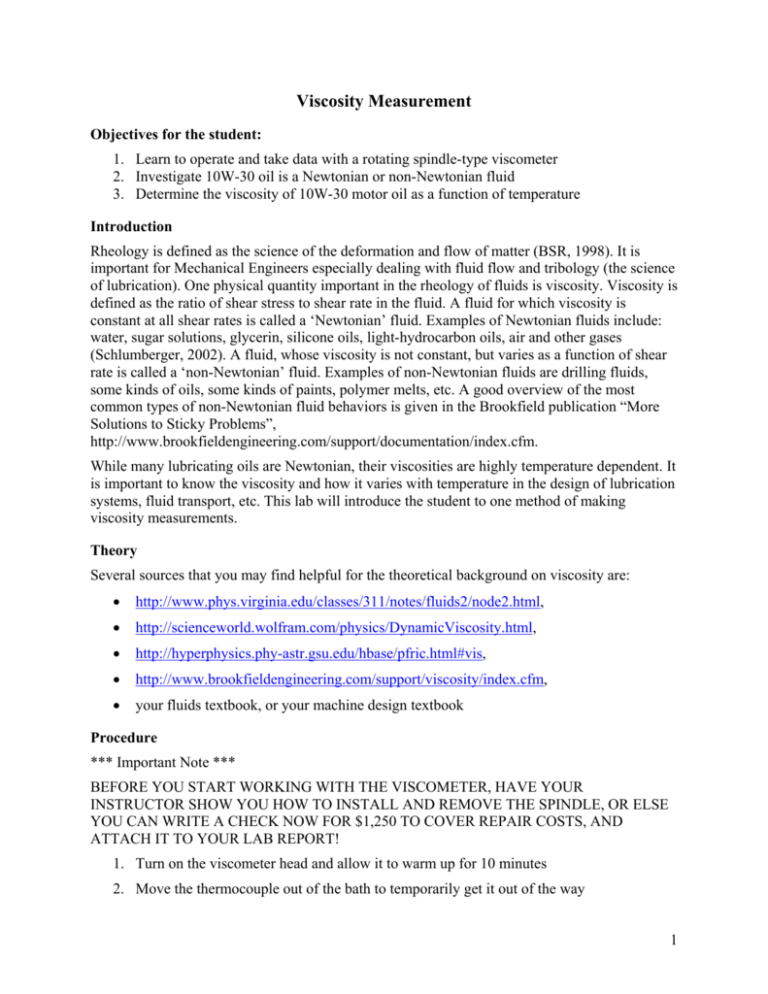
Viscosity Measurement Objectives for the student: 1. Learn to operate and take data with a rotating spindle-type viscometer 2. Investigate 10W-30 oil is a Newtonian or non-Newtonian fluid 3. Determine the viscosity of 10W-30 motor oil as a function of temperature Introduction Rheology is defined as the science of the deformation and flow of matter (BSR, 1998). It is important for Mechanical Engineers especially dealing with fluid flow and tribology (the science of lubrication). One physical quantity important in the rheology of fluids is viscosity. Viscosity is defined as the ratio of shear stress to shear rate in the fluid. A fluid for which viscosity is constant at all shear rates is called a ‘Newtonian’ fluid. Examples of Newtonian fluids include: water, sugar solutions, glycerin, silicone oils, light-hydrocarbon oils, air and other gases (Schlumberger, 2002). A fluid, whose viscosity is not constant, but varies as a function of shear rate is called a ‘non-Newtonian’ fluid. Examples of non-Newtonian fluids are drilling fluids, some kinds of oils, some kinds of paints, polymer melts, etc. A good overview of the most common types of non-Newtonian fluid behaviors is given in the Brookfield publication “More Solutions to Sticky Problems”, http://www.brookfieldengineering.com/support/documentation/index.cfm. While many lubricating oils are Newtonian, their viscosities are highly temperature dependent. It is important to know the viscosity and how it varies with temperature in the design of lubrication systems, fluid transport, etc. This lab will introduce the student to one method of making viscosity measurements. Theory Several sources that you may find helpful for the theoretical background on viscosity are: • http://www.phys.virginia.edu/classes/311/notes/fluids2/node2.html, • http://scienceworld.wolfram.com/physics/DynamicViscosity.html, • http://hyperphysics.phy-astr.gsu.edu/hbase/pfric.html#vis, • http://www.brookfieldengineering.com/support/viscosity/index.cfm, • your fluids textbook, or your machine design textbook Procedure *** Important Note *** BEFORE YOU START WORKING WITH THE VISCOMETER, HAVE YOUR INSTRUCTOR SHOW YOU HOW TO INSTALL AND REMOVE THE SPINDLE, OR ELSE YOU CAN WRITE A CHECK NOW FOR $1,250 TO COVER REPAIR COSTS, AND ATTACH IT TO YOUR LAB REPORT! 1. Turn on the viscometer head and allow it to warm up for 10 minutes 2. Move the thermocouple out of the bath to temporarily get it out of the way 1 3. Autozero the viscometer following the DV-II+ operating instructions. a. Remove the spindle. **** IMPORTANT NOTE **** ------> The spindle has a lefthanded thread, so it tightens and loosens in the opposite direction than the more often used right-handed thread. Also it is important to both lift the upper half of the drive and keep it from rotating with the thumb and forefinger of one hand while unscrewing the spindle with the other hand. You may need to raise the viscometer head out of the beaker to remove the spindle. b. Press any key on the viscometer keypad c. Wait until the display asks for the spindle to be replaced d. Replace the spindle paying careful attention to the items mentioned in a. above. Also make sure that when the spindle is submerged into the beaker, that the fluid to be measured reaches the groove on the spindle. Also make sure that the viscometer head is level (see the bubble level on the very top of the viscometer head). Level the head using the thumbwheels at the base of the stand. e. Press any key on the viscometer keypad 4. Put the thermocouple back in the oil. Put the tip of the thermocouple at about half of the disk radius away from the spindle centerline. Make sure that it is not touching the spindle! 5. Check that the correct Spindle Entry Code is being used. It must correspond with the spindle being used, so that the unit will display the correct Viscosity, Shear Rate and Shear Stress values. The simple disk-type spindles do not allow the software to calculate the shear stress and shear rate values. Why? Verify the correct spindle to use with your instructor. 6. Display the currently selected speed by pressing either the UP-arrow or DOWN-arrow 7. Set the speed to 180 RPM (or the highest RPM that will keep the torque below 100%) by pressing and holding one of the arrow keys until the number ‘180’ comes up. 8. Press the SET SPEED to accept 180 RPM as the spindle speed. 9. Turn on the spindle motor 10. Make sure that the temperature reading is in degrees F. 11. Start the Wingather32 program from the desktop. This is a program that the viscometer manufacturer wrote to communicate with the viscometer head. The main screen that first comes up is called the “dashboard”. It shows the same information that is displayed on the viscometer head. Verify this. Select the checkbox to turn off leading zero digits (“Show off segments”) to make the display easier to read. 12. Select the “Gather” tab in the program. This brings you to a screen, which will let you take data automatically from the viscometer head and save it in a spreadsheet-like format. You are first going to take viscosity readings over a range of speeds at a constant temperature, so select the “Manual” measurement mode. Once the “Start” button appears at the right side of the screen, click it to start taking data manually. Now, each time you click on the “Data” button, the program will take a measurement and display it the 2 window that looks like a spreadsheet. Take a few readings at the current speed, so you can assess the repeatability of your measurements. How much does the viscosity reading change in a few minutes? 13. Enter a new speed, and take at least one reading. Then, take data over as many speeds as you can where the % Torque reading stays at 10% or above. (Note: the manufacturer does not guarantee the stated repeatability if the torque reading drops below 10%, so beware.) 14. After you have taken data over all the speeds you can get valid data for, click on the “Stop” button at the right of the screen. You will automatically be taken to another screen, and all the data you have taken will be redisplayed in a spreadsheet format. After all your data appears, click on the “Export” button, so that you can save your data to a floppy disk. Clear the *.xls from the file name box, and enter a name without a file extension (the program will automatically enter .xls to your file name). Save the file to a floppy disk. Click on “Clear” to clear the buffer of the data you’ve taken. 15. Set the speed back to 180 RPM(or the highest RPM that will keep the torque below 100%), and turn the motor on. 16. Go back to Gather, and click on “Load” at the bottom left corner of the window. Browse to the C: drive and Viscometer Programs folder. Double click on the Viscometer Test program. The mode of this test is ‘Timed Stop’, where up to 200 readings will be taken every 10 seconds. Make sure that under ‘Follow-Up Events’, the “Save Data” box is checked, and the “Overwrite” radio button is indicated. Click ‘Start’ to begin taking data 17. Turn on the temperature controlled bath. Set the bath temperature to 200 deg. F using the knob (it may already be set). Enter this temperature using the membrane switch just above the power switch. 18. Stop the data acquisition when the oil reaches 180 deg F, or when the torque drops below 10%, whichever occurs first. 19. Export your data to a floppy disk. Make sure that you can open the disk on another computer that has Excel. Questions: 1. How well does the assumption of a Newtonian fluid fit your results? 2. How well do your results fit published data for this oil (10W-30)? 3. What do you predict the viscosity to be at 290 deg. F? References Brookfield Engineering Laboratories, Brookfield DV-II+ Programmable Viscometer Operating Instructions Manual no. M/97-164-d1000, http://www.brookfieldengineering.com/. Schlumberger Oilfield Glossary, http://www.glossary.oilfield.slb.com/Display.cfm?Term=Newtonian%20fluid, 2002 The British Society of Rheology (BSR), http://www.ncl.ac.uk/rheology/bsr/noframes/index.html 3
